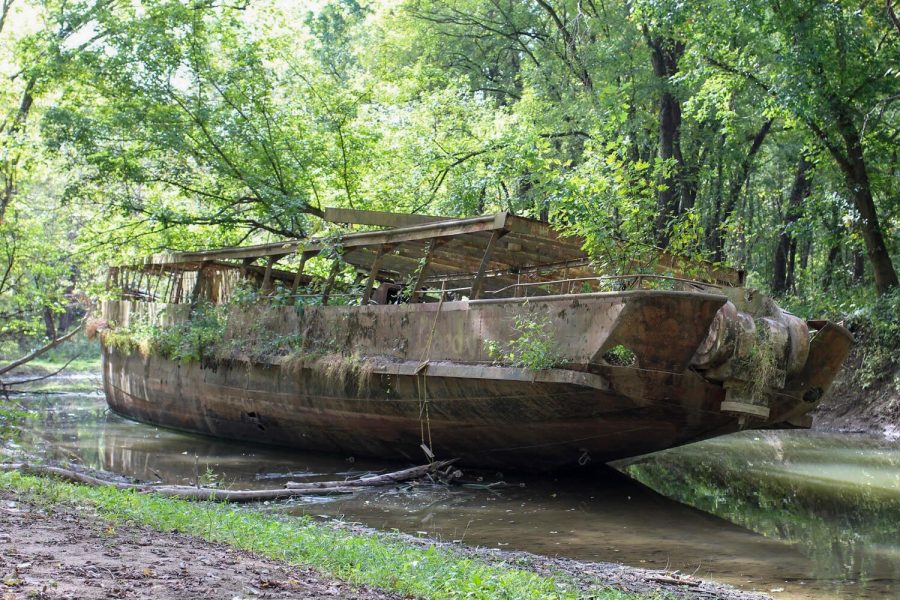Remains of historic ship rest in Boone County creek
Photo from Reddit user lasermanmcgee. Used with permission.
Remains of the Sachem rest in Boone County’s Taylor Creek, but trespassing on the site is illegal and potentially dangerous.
April 29, 2022
Supposedly haunted, the Sachem, aka the “Ghost Ship,” is one of America’s most historic ships, and its remains are located in Boone County.
Currently, the ship is a shell of its former self, rusted and overgrown with brush and wildflower. At its peak, however, the USS Sachem was a luxury racing yacht named “Celt,” a patrol boat in both World Wars, a floating laboratory for Thomas Edison, a sightseeing ship in New York, and a background character in a Madonna music video.
“It had so many different jobs,” local historian Hillary Delaney said. “It was launched around 1902 as a private luxury yacht for (a man) named (John) Maxwell.”
Maxwell, a wealthy businessman from Delaware, named the boat the “Celt,” and intended it to be a racing ship in addition to a pleasure boat.
By the time World War I rolled around however, the U.S. Navy requisitioned the boat and renamed it the “USS Sachem.”
“(The Navy) required the owner to surrender the boat for national defense purposes,” Delaney said. “Those pleasure boats were sort of more agile to patrol the coast.”
At the time, the Celt had already been renamed into the “Sachem” by a new owner—a man from New York named Manton Metcalf.
The renaming of the Sachem into the USS Sachem (aka the SP-192) was ordered for identification purposes, SP meaning “Section Patrol.”
Technically, the USS Sachem was a steamboat, meaning it was primarily powered by steam, allowing it to navigate waters more effectively than flatboats or battleships.
Also during this time, the Navy tasked famous inventor Thomas Edison with developing marine technology for the United States. In the spring of 1917 Edison and his associates were assigned to the USS Sachem to conduct their work.
“It was used as sort of a floating lab because Edison was trying to come up with a ‘masking technology’ having to do with the detection of submarines, as well as masking the presence of the boat (the USS Sachem) too,” Delaney said.
Just a little under two years later, Edison lost his funding for the project and returned to his normal activities. Despite rumors that Edison developed up to 50 ideas–including the masking technology, a smoke bomb for concealing ships, and a specialized anchor that would supposedly work as a means for evading enemy torpedoes–the U.S. Navy reportedly put none into production.
After WWI, the boat was auctioned off to a Pennsylvania man named Roland Taylor. Taylor, a banker, used the boat to traffic rum and other alcohols throughout the 1920s (a period where prohibition was widespread).
By the time the Great Depression hit, Taylor was forced to sell the USS Sachem to Jacob Martin, a Brooklyn-based fisherman. Up until the early 1940’s, Martin would charge people $2 (approximately $40 today) to party, fish, or simply lounge on the ship.
When the U.S. entered WWII, the USS Sachem was seized by the Navy to once again serve as a patrol boat.
This time, it was heavily equipped with armor, weapons, a new paint job, and a new name—the USS Phenakite (PYc-25). The boat saw no active combat in its time in both World Wars.
Following WWII, the USS Phenakite was purchased by Circle Line Sightseeing Cruises of New York and was renamed the “Sightseer,” serving as the company’s flagship.
The Sightseer would undergo another paint job to look more suitable for sightseeing, and then would be renamed two last times, the “Circle Line Sightseer” in the early 1950s and then, a few years later, the “Circle Line V.”
In 1977 the Circle Line V would be decommissioned by the Circle Line company and thus its 75ish years as an active boat would come to an end. Once again it would be referred to as the Sachem as it sat abandoned at a dock in New York City.
During its near decade-long time at the dock, the Sachem would briefly be featured in the music video for Madonna’s song “Papa Don’t Preach.”
In 1984, the Sachem would be sold to its final owner, a Cincinnati man named Robert Miller.
Miller purchased the ship for an estimated $7,500 and moved it out of the dock over the course of ten days via bulldozer.
So, how did the Sachem end up in Boone County? According to Delaney, Miller moved the ship across from New York to Cincinnati over the course of a month, and the ship ended up at the Ohio river.
Just a few days later, the Sachem would sail into its final resting place: a creek bed in Boone County. Here, it would become continuously waterlogged over the course of a few decades and eventually reach the point where it could no longer be restored—Miller’s original intention.
“(Miller) had every intention to restore it,” Delaney said. “It was just a really hard task to take on … it just got to the point where it was impossible to save it.”
“He (Miller) worked with a non-profit in Lawrenceburg and launched a campaign to restore the Sachem and it just didn’t take off … that’s why it stayed in the creek,” Delaney finished.
Delaney stressed that “it’s not only dangerous, but also illegal” to visit the Sachem in its current state.
“The property owners don’t want anybody going over there … they’re just so worried that somebody is going to get hurt, and of course they don’t want people tramping around on their property,” she said.
The Sachem will likely stay where it is for the foreseeable future, but even after it finally perishes, its rich history will keep it alive.
